10 OSINT Tools for Technology Sector Threats
Open-source intelligence (OSINT) tools are essential for identifying and mitigating cyber threats in the tech industry. With increasing risks like supply chain attacks, brand impersonation, and advanced cybercrime tactics, these tools help companies monitor vulnerabilities, detect risks, and safeguard their digital ecosystems. Here’s a quick overview of 10 OSINT tools tailored for tech security:
- The Security Bulldog: AI-powered platform for analyzing and organizing threat intelligence with role-based customization. Starting at $850/month.
- Maltego: Visual mapping tool for uncovering connections between data points, ideal for threat hunting and forensics.
- Shodan: Internet-connected device search engine for asset discovery and attack surface management.
- Censys: Focuses on certificate transparency and host fingerprinting to monitor SSL/TLS risks and supply chain vulnerabilities.
- TheHarvester: Open-source tool for collecting emails, subdomains, and hostnames during reconnaissance.
- VirusTotal: Multi-engine malware and URL analysis tool for quick threat detection and incident response.
- AbuseIPDB: Collaborative IP reputation database to track and block malicious IPs.
- Intelligence X: Deep web search engine for breach analysis and tracking underground threats.
- Crimewall by Social Links: Social media intelligence tool for identifying coordinated social engineering threats.
- Recon-ng: Command-line framework for automated reconnaissance with modular data collection.
These tools vary in features, pricing, and complexity, making it important to select the right combination for your organization’s needs. Combining tools often yields better results, such as using Shodan for reconnaissance, Maltego for data mapping, and The Security Bulldog for ongoing threat monitoring.
Top 10 FREE OSINT tools (with demos) for 2024 – And FREE OSINT course!
Quick Comparison
| Tool | Main Use Case | Key Features | Limitations | Cost |
|---|---|---|---|---|
| The Security Bulldog | AI-driven threat intelligence | NLP engine, custom feeds | High cost | $850/month |
| Maltego | Visual data mapping | Graphs, transforms | Steep learning curve | Free/Commercial |
| Shodan | Device discovery | Port scanning, real-time alerts | Data gaps, limited free tier | Free/Subscription |
| Censys | SSL/TLS monitoring | Certificate tracking, host profiling | Limited IoT coverage | Free/Paid |
| TheHarvester | Reconnaissance | Email, subdomain enumeration | Manual operation | Free |
| VirusTotal | Malware/URL analysis | Multi-engine scanning | API limits, false positives | Free/Paid |
| AbuseIPDB | IP reputation | Community-driven reports | False positives | Free/Paid |
| Intelligence X | Deep web monitoring | Dark web data, historical archives | Costly, complex interface | Free/Paid |
| Crimewall | Social media intelligence | Multi-platform analysis | Privacy limitations | Paid |
| Recon-ng | Automated reconnaissance | Modular framework | Requires technical expertise | Free |
Selecting the right tools depends on your security goals, budget, and technical expertise. A balanced mix of tools ensures comprehensive coverage against cyber threats.
1. The Security Bulldog
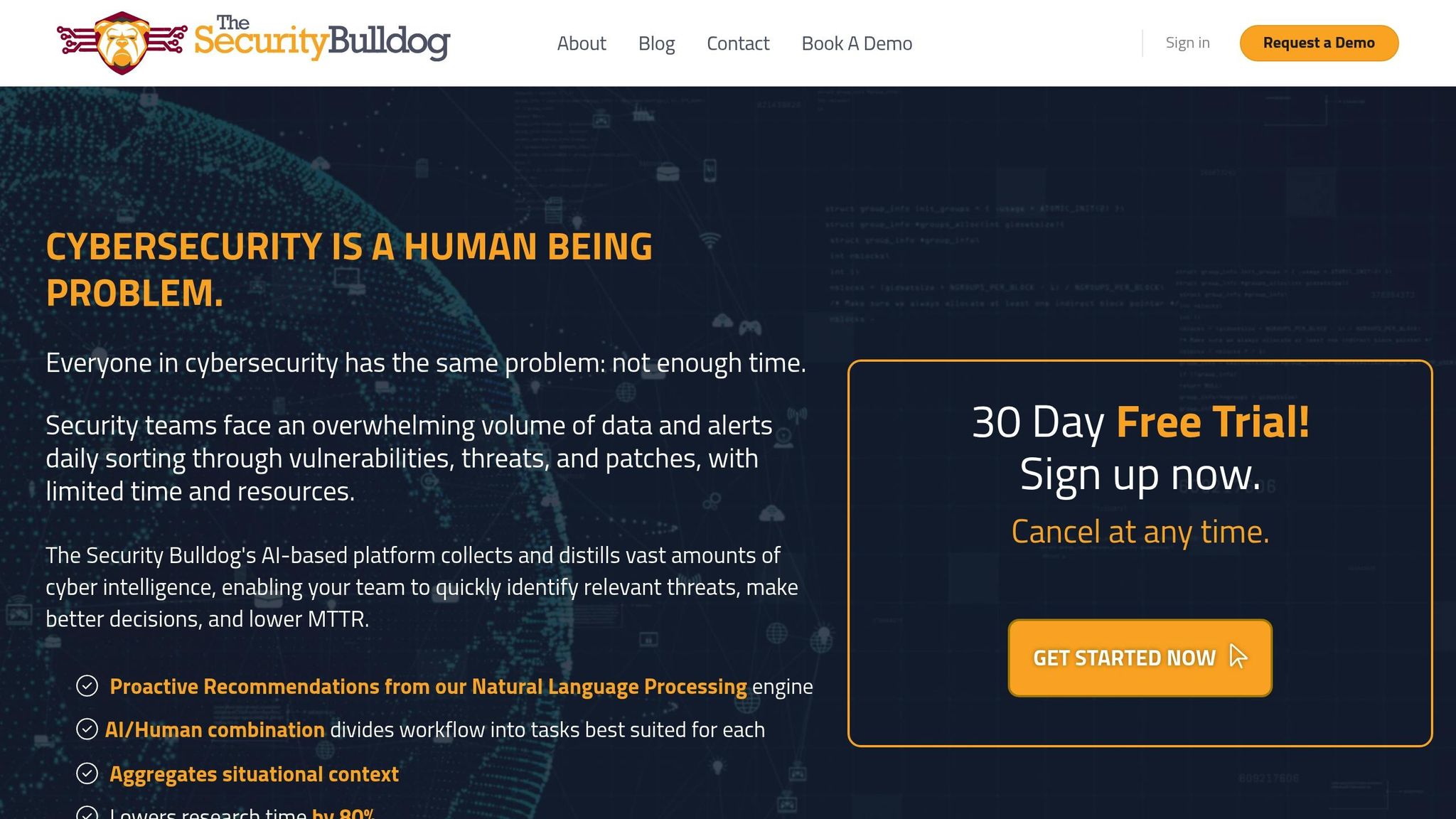
The Security Bulldog is an AI-driven platform designed to simplify OSINT (Open Source Intelligence) for tech companies. At its core, it uses a proprietary NLP engine to sift through massive amounts of cyber threat data, offering a practical solution for organizations dealing with complex security issues.
Primary Use Case
This platform specializes in transforming cyber intelligence into actionable insights tailored to various cybersecurity roles. Tech teams rely on The Security Bulldog to keep an eye on new threats, track vulnerabilities, and detect attack patterns specific to their industry. It’s particularly useful for organizations needing to process large quantities of threat intelligence swiftly while ensuring the information is accurate and relevant.
Key Features
The Security Bulldog leverages advanced AI and NLP to pull in data from a variety of sources, including threat frameworks, vulnerability databases, news feeds, podcasts, CVEs, and MITRE ATT&CK data. It organizes this information into customized feeds that align with specific IT environments. Its standout features include:
- Semantic analysis: Identifying context and connections between different threat indicators.
- Custom feed creation: Generating tailored intelligence for unique technology stacks.
- Integration options: Connecting seamlessly with existing SOAR and SIEM tools.
- Collaboration tools: Helping security teams share insights and coordinate responses efficiently.
Strengths
What sets The Security Bulldog apart is its proprietary NLP engine, which automatically analyzes and correlates threat data from multiple sources, cutting down on research time. The platform’s role-based customization ensures that insights are relevant to specific users, such as analysts, SOC managers, or CISOs. Plus, its straightforward setup and ability to import and export internal data make it easy for tech companies to integrate into their current security workflows.
Limitations
The platform comes with a subscription model, starting at $850 per month or $9,350 annually for up to 10 users. While this pricing might work for larger organizations, it could be a significant expense for smaller tech firms. Additionally, the Enterprise Pro plan requires custom pricing, which can complicate budget planning for businesses with tight financial constraints.
Next, let’s take a closer look at Maltego, another essential OSINT tool for the tech industry.
2. Maltego
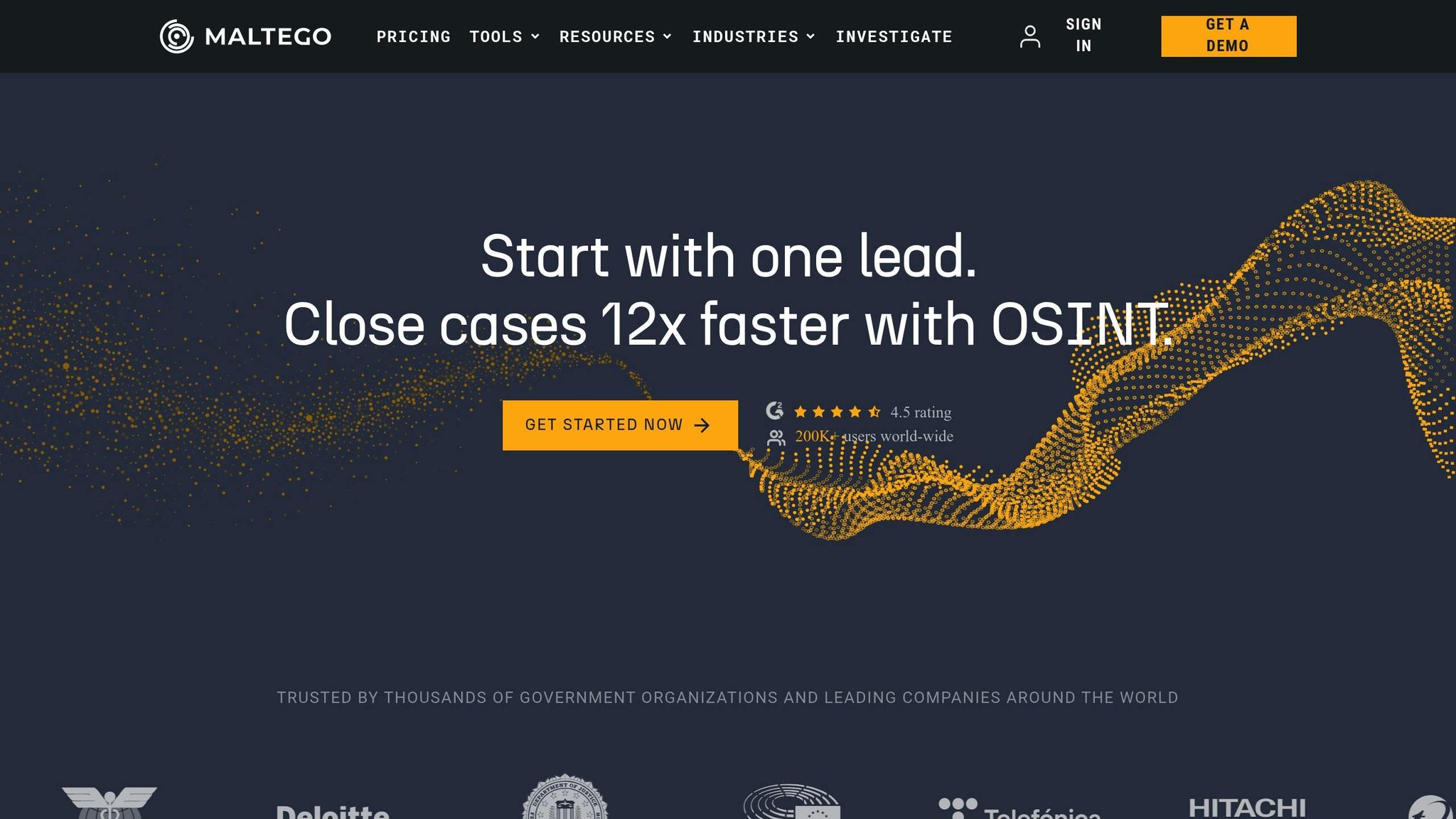
Maltego is a tool designed to visually map data relationships, helping users identify hidden connections that might be overlooked in standard text-based reports. By transforming raw intelligence into interactive graphs, it simplifies the process of spotting links between various data points.
Primary Use Case
Maltego is widely used by technology companies for threat hunting and digital forensics investigations. Its strength lies in connecting disparate pieces of information, such as IP addresses, domains, social media profiles, email addresses, and malware, to potential command-and-control servers.
Key Features
Maltego leverages automated transforms to gather and display data as interconnected nodes. These transforms include DNS lookups, WHOIS queries, social media searches, and threat intelligence feeds. Users can drag and drop entities onto the workspace to trigger transforms that uncover related data. Additionally, organizations can use custom transforms to integrate their proprietary data sources or specialized threat intelligence feeds, tailoring the tool to their specific needs.
Strengths
The platform excels at revealing complex relationships quickly, making it easier to detect attack patterns. Its visual mapping capabilities and extensive library of transforms allow for efficient analysis and seamless export of findings for reporting purposes. Maltego also supports collaborative features, enabling investigation teams to share graphs and build on each other’s work.
Limitations
Maltego’s performance heavily relies on the quality of its data sources, meaning outdated or inaccurate data can lead to flawed conclusions. New users may encounter a steep learning curve, as mastering the tool’s features and optimizing its use requires time and effort. While a free Community Edition is available, it comes with limitations on transforms and results. To unlock the tool’s full potential, users often need a commercial license, which can be a significant investment.
Next, we’ll explore another critical tool for threat intelligence.
3. Shodan
Shodan stands out as a powerful tool in the world of OSINT, offering a unique way to map and analyze the digital infrastructure of the internet.
At its core, Shodan functions as a search engine, but instead of indexing websites, it catalogs internet-connected devices. From web servers to industrial control systems, it scans and identifies open ports, services, and banners across millions of IP addresses, creating a detailed map of the internet’s infrastructure.
Primary Use Case
Shodan is widely used by technology companies for asset discovery and attack surface management. Security teams depend on it to uncover exposed devices that might otherwise go unnoticed. It’s particularly effective for spotting misconfigured servers, unsecured databases, and vulnerable IoT devices – potential weak points that attackers could exploit.
Key Features
Shodan’s banner grabbing capability pulls information on software versions, configurations, and known vulnerabilities. Its advanced filters allow users to refine searches by parameters like country, organization, operating system, or service type. For large-scale operations, the platform’s API integration supports automated queries and bulk data collection. Shodan also offers real-time monitoring, sending alerts when devices matching specific criteria appear online.
Strengths
One of Shodan’s standout qualities is its extensive coverage, scanning over 500 ports and maintaining a constantly updated database of internet-connected devices worldwide. Its intuitive search syntax makes it accessible for both beginners and seasoned professionals, enabling precise queries with ease. Shodan is particularly adept at uncovering shadow IT assets – devices or services that organizations might not realize are part of their infrastructure. Additionally, its historical data feature helps track changes in an organization’s attack surface over time, offering insights into how their infrastructure has evolved.
Limitations
Despite its strengths, Shodan isn’t without its challenges. The data it collects can sometimes include false positives, especially when devices use non-standard configurations. Additionally, the platform’s scanning frequency can vary, meaning some data might be outdated by the time it’s accessed. While Shodan does offer a free tier, organizations needing advanced features or higher query limits will need to invest in paid subscriptions, which can get pricey for extensive use. Another limitation is that some countries and organizations actively block Shodan’s scans, creating geographical blind spots in its data.
Up next, we’ll dive into a tool that specializes in certificate transparency and internet-wide scanning. Stay tuned!
4. Censys
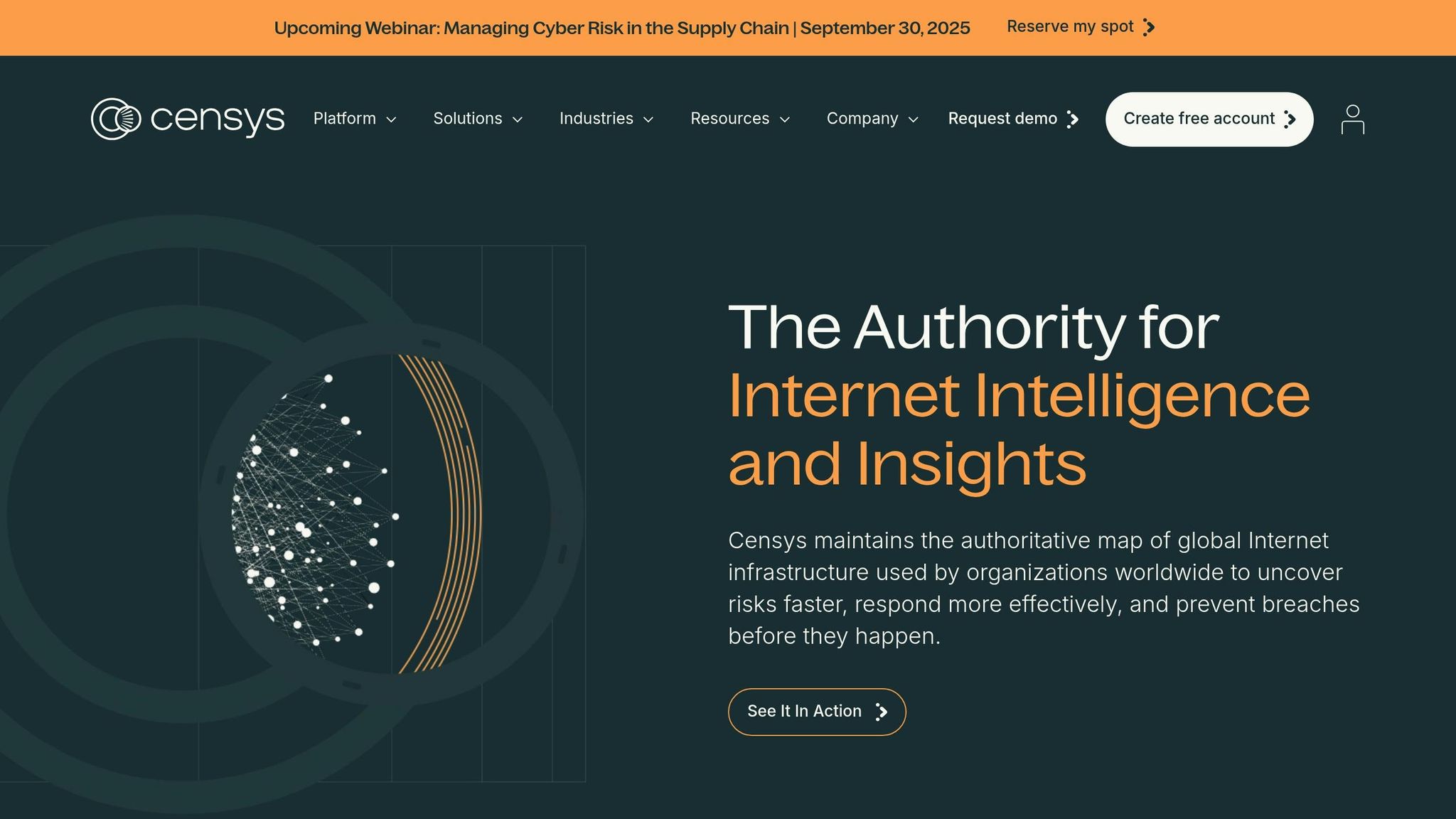
Censys is a platform designed around certificate transparency and host fingerprinting. It continuously scans the entire IPv4 address space, building a comprehensive database of certificates, hosts, and services. What makes Censys stand out is its ability to track certificate chains and deliver detailed insights into digital certificates.
Primary Use Case
Censys is particularly effective for certificate management and SSL/TLS monitoring, making it a go-to tool for technology organizations. Security teams use it to keep tabs on expiring certificates, detect unauthorized or rogue certificates, and monitor certificate transparency logs for potential threats. This streamlines the process of identifying and addressing certificate-related risks.
Beyond certificates, Censys also shines in supply chain security assessments. By analyzing patterns in certificates and host configurations, it helps organizations identify third-party services and vendors tied to their infrastructure. This insight is key for mapping potential vulnerabilities linked to business partners.
Key Features
Censys goes beyond basic SSL monitoring with robust certificate tracking. Its integration with certificate transparency logs offers real-time visibility into newly issued certificates, flagging unauthorized domains or possible phishing attempts. The host discovery engine adds another layer, providing service fingerprinting with details like version information and configurations.
The platform’s search and filtering capabilities enable users to run complex boolean queries, making it easier to pinpoint specific vulnerabilities or configurations across large datasets. Additionally, Censys includes historical data analysis, allowing security teams to track changes in their attack surface, spot trends in certificate usage, and monitor service deployments over time.
Strengths
Censys’s specialization in certificate transparency makes it an invaluable tool for organizations that require strict oversight of their SSL/TLS infrastructure. Its data is known for its accuracy, and the metadata it provides goes beyond simple port scanning, offering deeper context.
The platform’s ability to maintain historical records is another major strength. This feature allows teams to analyze long-term trends, understand how threats evolve, and monitor changes in their attack surface. Moreover, its API accessibility ensures seamless integration with existing security workflows and automated systems.
Limitations
While Censys has many strengths, it does come with some limitations. Its scanning coverage is less extensive than some competitors, particularly when it comes to non-standard ports and services. For organizations focused on IoT device discovery, this can result in data gaps.
Another challenge is the platform’s learning curve, especially for users who are not familiar with certificate management or SSL/TLS concepts. Its powerful search functionality requires a solid understanding of these areas to be fully effective. Additionally, Censys’s pricing can deter smaller organizations, as advanced features and higher query limits often come at a steep cost. While the platform excels at keeping certificate data current, some host configuration details may lag, potentially missing short-lived threats.
Up next, we’ll look at a tool that takes a different approach to automating reconnaissance.
5. TheHarvester
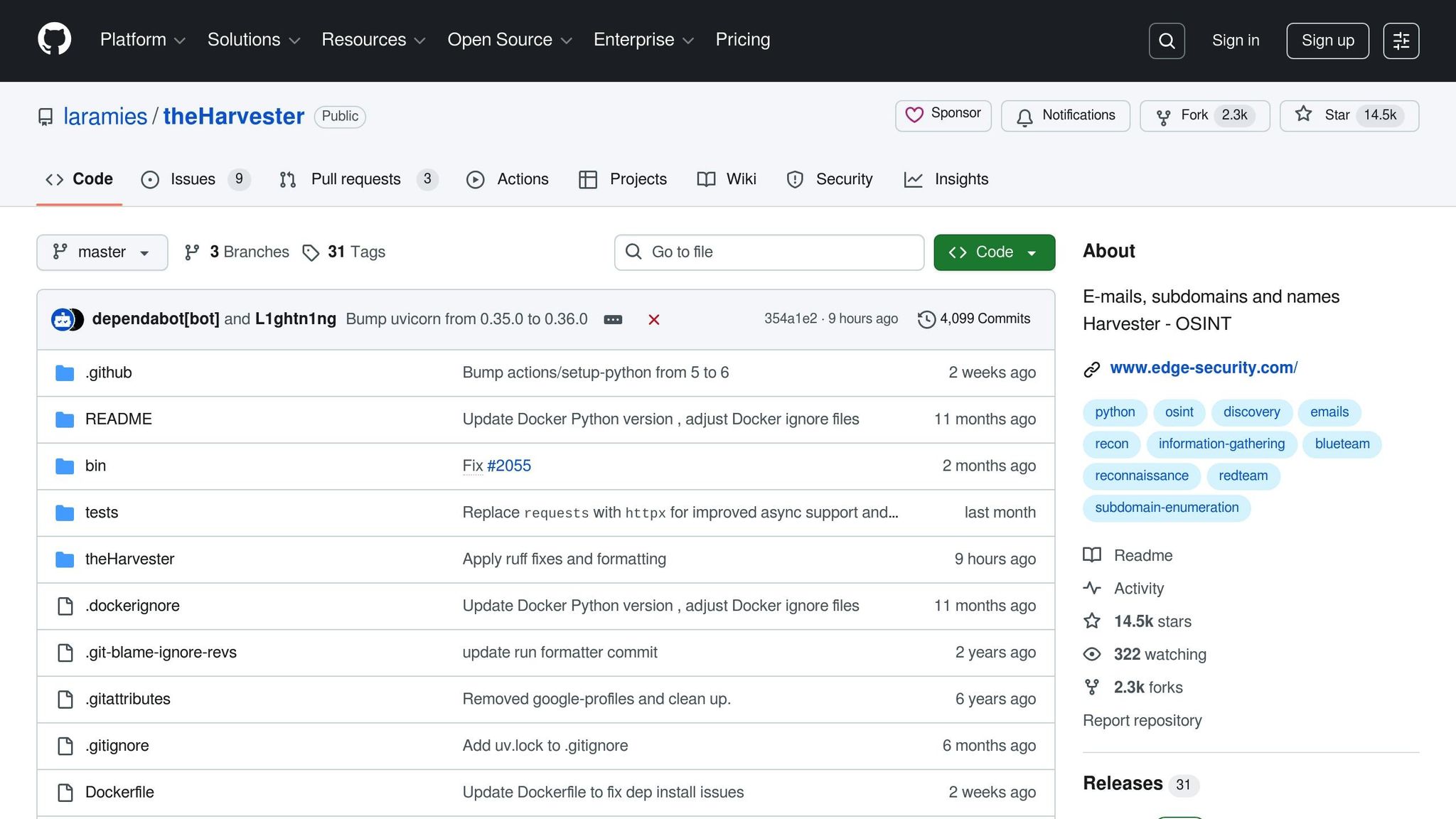
TheHarvester is an open-source reconnaissance tool designed to automate the collection of publicly available data. It pulls information from a variety of sources, including search engines and PGP key servers, to gather email addresses, subdomains, and hostnames.
Primary Use Case
TheHarvester is particularly useful during the early stages of threat assessment and penetration testing. It helps map out an organization’s digital footprint, making it invaluable for evaluating email security and identifying potential phishing risks. Additionally, it can uncover forgotten subdomains and other digital assets, providing a clearer picture of attack surfaces, especially in cloud environments.
For technology companies, TheHarvester can serve as a proactive tool to audit publicly accessible information before launching new products or services.
Key Features
One of the standout aspects of TheHarvester is its ability to pull data from an extensive range of sources. It queries public search engines, specialized databases like SHODAN, and employs DNS brute-forcing and passive discovery techniques to reveal hidden assets. The command-line interface supports scripting, making it easy to integrate into automated security workflows. Moreover, it offers flexible output formats, allowing users to export results as XML, HTML, or plain text.
Strengths
As an open-source tool, TheHarvester is a budget-friendly option that’s accessible to organizations of all sizes. It streamlines data collection, saving time compared to manual methods, and its passive approach minimizes detectable activity. Regular updates from an active community ensure the tool stays compatible with changing data sources and search engine protocols.
Limitations
The tool’s performance relies heavily on the availability and responsiveness of its data sources. Some search engines may enforce rate limits or require API keys, which can slow down the process. Additionally, the data it collects isn’t always up-to-date, so manual verification may be necessary. For users unfamiliar with command-line tools, the interface might present a bit of a learning curve compared to graphical alternatives.
Next, we’ll explore a tool designed for analyzing files and URLs to gather threat intelligence.
sbb-itb-9b7603c
6. VirusTotal
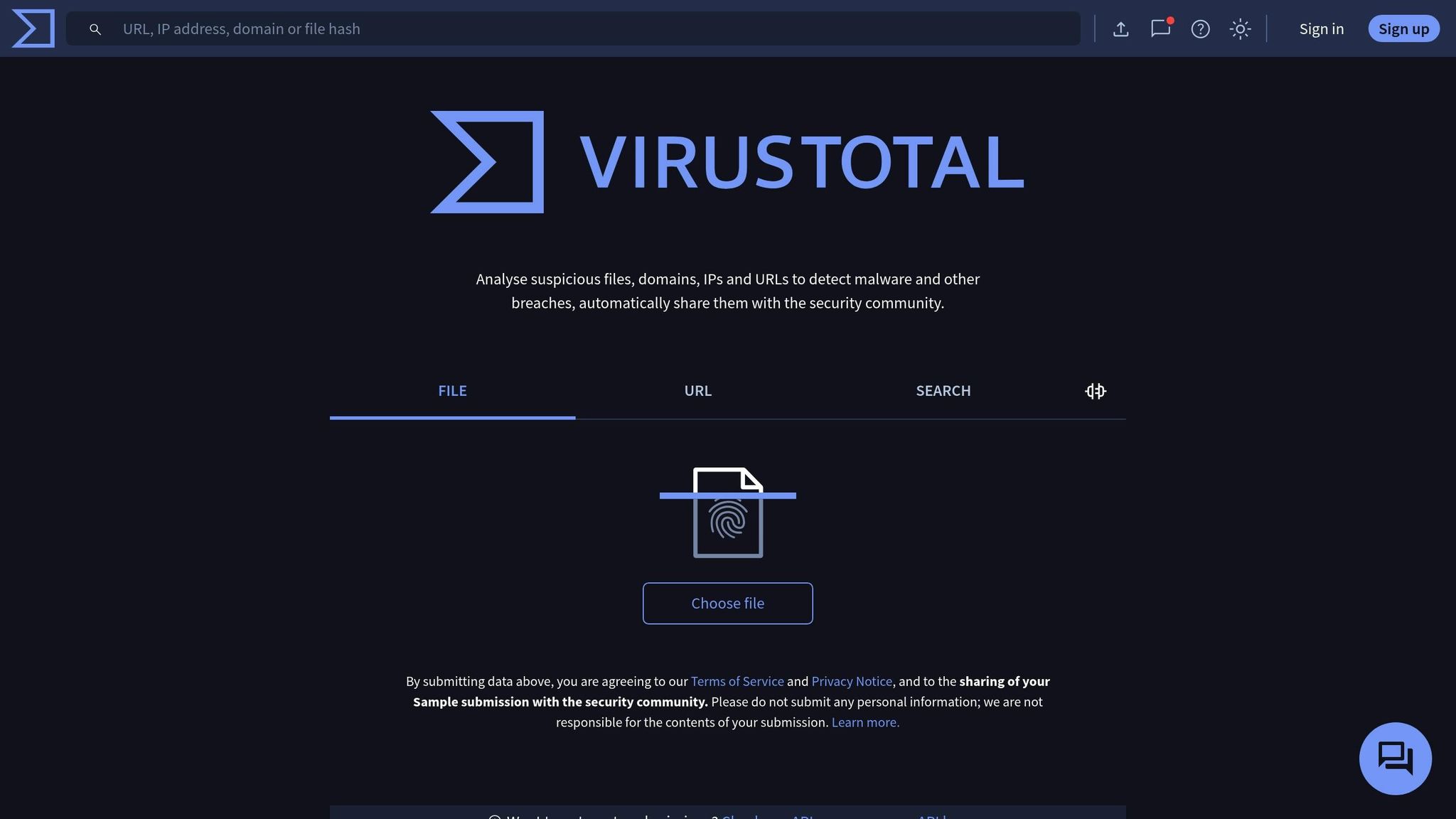
VirusTotal is a widely used service that analyzes files, URLs, domains, and IP addresses by leveraging multiple antivirus engines and security tools. Over time, it has become a go-to platform for detecting malware and gathering threat intelligence.
Primary Use Case
VirusTotal acts as a central hub for verifying and analyzing potential threats in digital environments. Security teams rely on it to quickly determine whether files, websites, or network resources are dangerous, helping to prevent potential system compromises. Its standout feature is multi-engine analysis, which cross-references results from dozens of antivirus solutions, offering a reliable and comprehensive security assessment.
For tech companies, VirusTotal proves particularly useful in incident response scenarios where quick evaluations of suspicious files or URLs are critical. It also supports proactive security efforts by enabling teams to scan software updates, third-party tools, and user-submitted content before deployment.
Key Features
VirusTotal’s multi-engine scanning is its cornerstone, utilizing over 70 antivirus engines and URL/domain blacklisting tools to analyze threats. The platform also maintains a robust database of historical scans, community feedback, and behavioral insights.
Users can interact with VirusTotal through a web interface or API access, making it suitable for both manual reviews and automated workflows. The platform allows file uploads up to 650 MB, URL submissions, and scans of entire domains or IP ranges. Additionally, its community features enable security professionals to share insights and vote on flagged items, fostering collaboration.
The platform’s behavioral analysis is another key strength. It can execute suspicious files in controlled environments to examine their runtime behavior, network activity, and system modifications. This dynamic approach complements traditional signature-based detection methods, offering a more detailed threat evaluation.
Strengths
One of VirusTotal’s major advantages is its free tier, which makes it accessible to businesses and individuals alike. The platform is also fast – most file scans are completed within minutes, while URL analyses are nearly instant.
The service retains historical data, allowing users to track threat evolution and identify patterns in attack campaigns over time. Its community-driven intelligence adds another layer of accuracy, with security experts worldwide contributing to threat identification and classification.
Limitations
The free tier comes with rate limits on API calls – restricted to four requests per minute – which can slow down automated processes for larger organizations.
Another challenge is the occurrence of false positives, where legitimate files are flagged as threats by overly sensitive antivirus engines. This often requires manual verification to ensure accuracy. Additionally, some advanced malware uses evasion techniques to bypass detection by automated systems like VirusTotal.
Lastly, the platform’s effectiveness depends heavily on the coverage and quality of the antivirus engines it integrates. Zero-day threats or highly sophisticated malware may escape detection if the signature databases are outdated or incomplete.
Next, we’ll take a closer look at a tool designed specifically for tracking malicious IPs and analyzing network threats.
7. AbuseIPDB
AbuseIPDB is a collaborative database where cybersecurity professionals report and monitor malicious IP addresses. This platform, powered by community contributions, provides real-time insights into IPs linked to cyberattacks, spam, and other harmful activities. It’s a valuable tool for technology companies aiming to stay ahead of emerging threats.
Primary Use Case
AbuseIPDB is primarily used for IP reputation analysis and sharing threat intelligence. Security teams rely on it to determine if specific IP addresses have been flagged for malicious behavior before allowing connections or processing traffic.
The platform is especially useful during incident response when teams need to quickly evaluate the reputation of suspicious IPs. Many companies integrate AbuseIPDB into their workflows to automatically block traffic from problematic IPs, reducing the risk of successful attacks.
For those engaged in proactive threat hunting, AbuseIPDB allows analysts to search IP ranges, review activity across entire network segments, and uncover patterns in malicious behavior. This is particularly helpful for organizations managing large infrastructures or facing distributed attack scenarios.
Key Features
AbuseIPDB offers a range of features designed to enhance threat detection and response:
- Community Reporting System: Users can submit reports detailing malicious IP activities, including attack types, timestamps, and evidence. These reports contribute to a confidence score, helping assess the reliability of the threat data.
- API Integration: The platform supports API access, with the free tier allowing up to 1,000 IP checks per day, making it easy to incorporate into automated workflows.
- Geolocation and ISP Data: Provides context about reported IPs, including their origins and associated internet service providers, helping teams trace attack sources.
- Historical Data: Tracks when IPs were first flagged and how their activity has evolved, offering a timeline of malicious behavior.
- Threat Classification: Categorizes threats into types like brute force attacks, web application exploits, SSH attacks, mail server abuse, and botnet activity, enabling more precise defensive strategies.
Strengths
AbuseIPDB’s community-driven model ensures a constantly updated and comprehensive database of threats. Contributions from security professionals worldwide keep the platform current with emerging attack trends.
The platform’s real-time updates are a major advantage, enabling organizations to identify and block malicious IPs as soon as they’re reported. Additionally, its integration capabilities make it easy to connect with existing security tools and firewalls, streamlining automated threat detection and response.
Limitations
Despite its strengths, AbuseIPDB has some challenges. False positives can occur, especially in cases where legitimate IPs are flagged due to abuse by individual users, such as on shared hosting services or public Wi-Fi networks.
The free API tier’s limit of 1,000 calls per day may not meet the needs of larger organizations with extensive monitoring requirements. Additionally, the platform’s effectiveness relies heavily on community participation – if certain IPs aren’t reported, they won’t appear in the database, leaving potential blind spots.
Next, we’ll dive into a powerful search engine that aggregates intelligence from multiple data sources.
8. Intelligence X
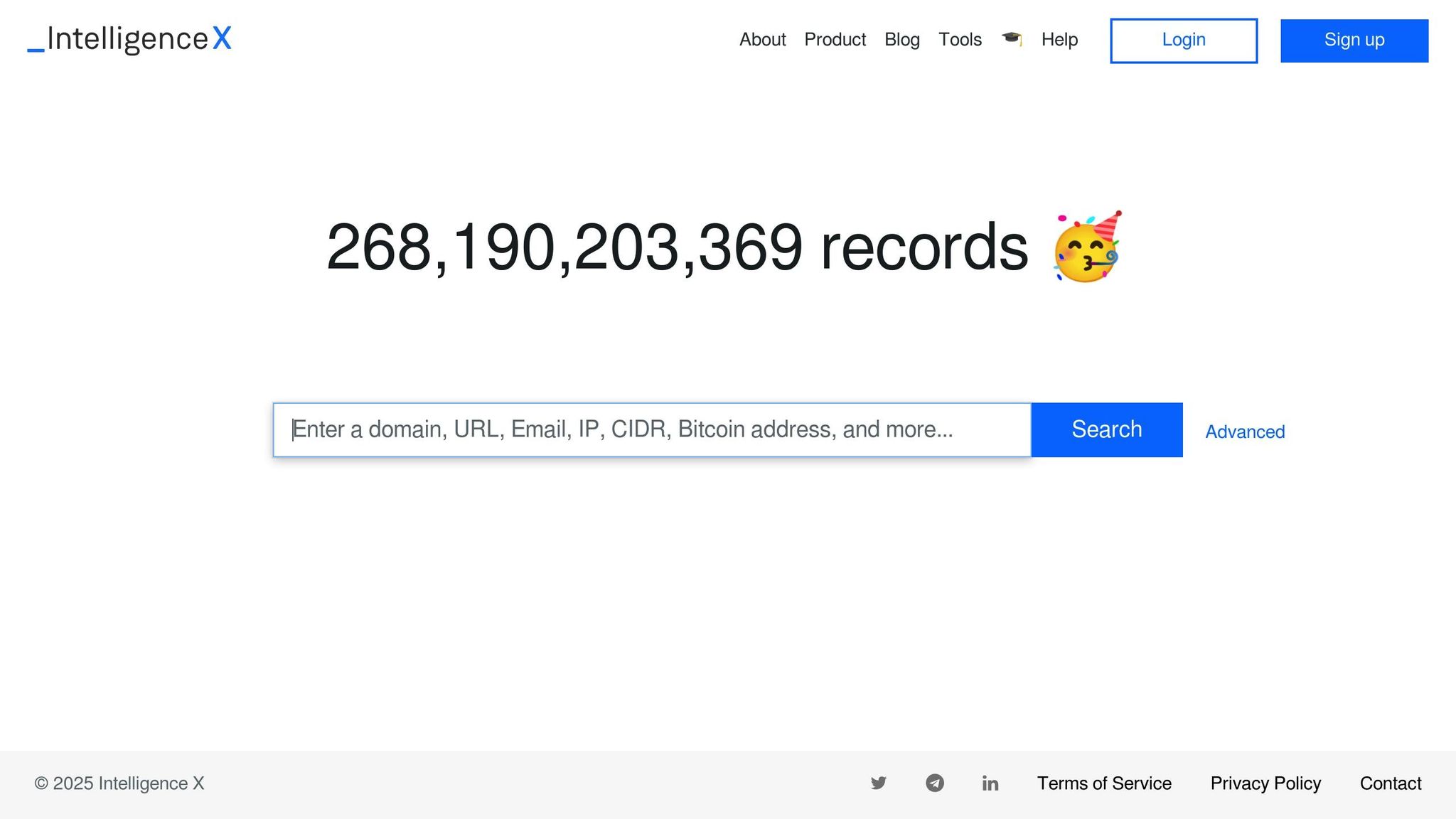
When it comes to uncovering hidden online data, Intelligence X stands out. Unlike traditional search engines, this platform dives into the depths of the internet, exposing underground discussions and data breaches. By doing so, it adds an important layer to the threat landscape covered by OSINT tools, offering cybersecurity professionals a valuable resource.
Primary Use Case
Intelligence X is a go-to tool for cybersecurity experts, especially those in the tech industry. Its primary role is to identify emerging threats, track malicious actors, and uncover vulnerabilities before they hit the mainstream radar. One of its standout capabilities is in data breach analysis, helping security teams evaluate the fallout from breaches by locating compromised data and tracing its spread across platforms. It also aids in vulnerability research, shedding light on exploit discussions happening in hidden online communities.
Key Features
This platform uses a highly targeted search system, focusing on specific indicators like email addresses, domains, URLs, IP addresses, and even Bitcoin addresses. Intelligence X also archives historical versions of web pages, which is incredibly useful for trend analysis. Its API integration allows security teams to seamlessly incorporate its search functionality into their existing workflows. Additionally, it preserves web content that has been removed due to legal actions or censorship, including data from sources like government sites, WikiLeaks, and various data leaks.
Strengths
One of the tool’s biggest strengths is its dark web coverage, with an extensive index of hidden forums, marketplaces, and communication channels where cybercriminals operate. Its historical preservation feature is another highlight, enabling teams to track the evolution of threats or malicious actors over time. The platform’s selector-based searches are precise, cutting through irrelevant data to deliver results that matter most when investigating specific indicators of compromise.
Limitations
Intelligence X uses a lookup-based pricing model. The free tier allows for 50 daily lookups, while the Researcher plan expands this to 200. While this pricing structure may work for some, it could be a limitation for teams with higher data demands.
9. Crimewall by Social Links
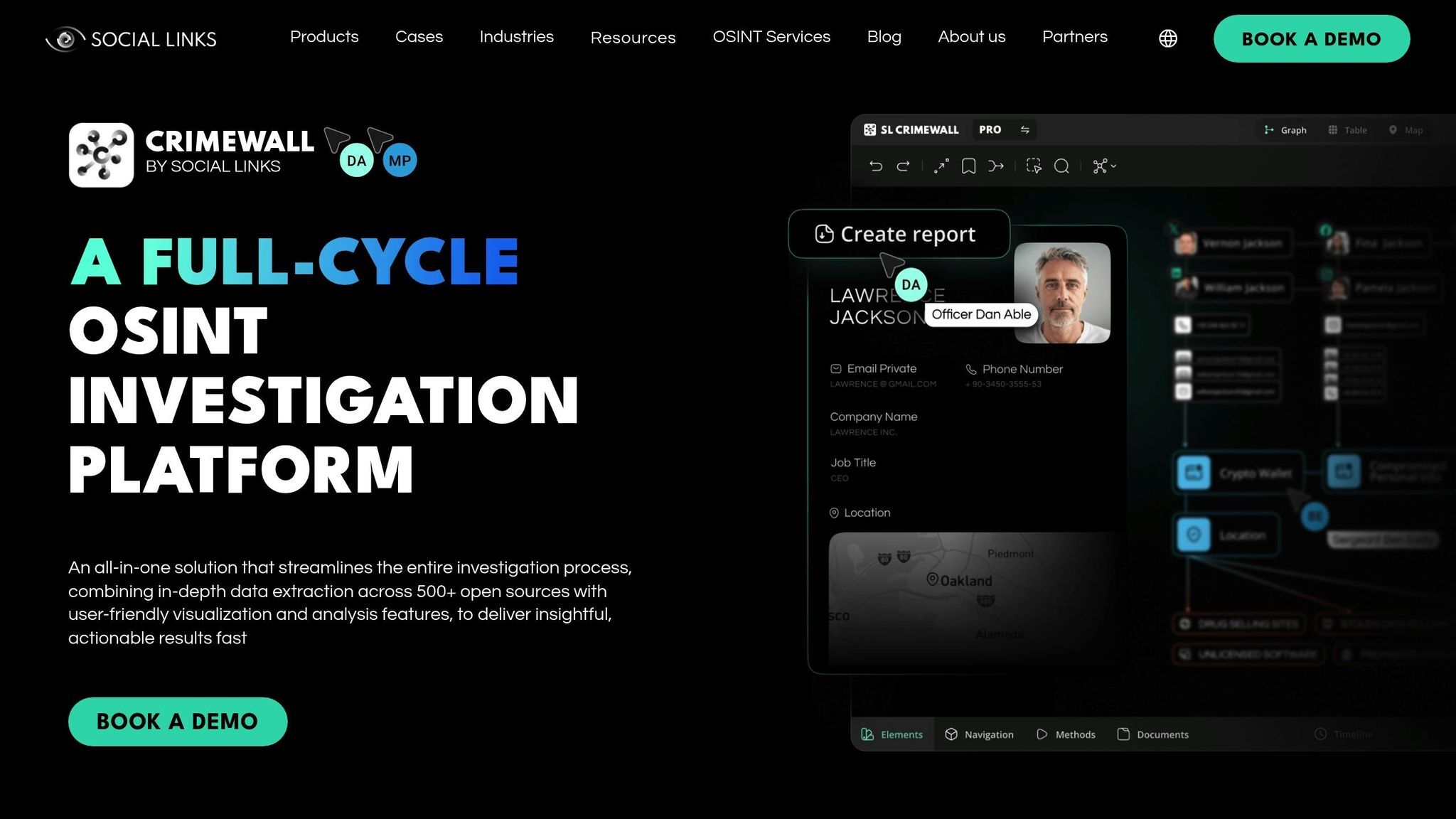
Crimewall by Social Links is an OSINT tool designed to analyze social media and messaging data, helping tech security teams uncover coordinated social engineering threats.
Primary Use Case
This tool excels at gathering intelligence from social media platforms and online communities. Security teams rely on it to detect patterns that may indicate coordinated social engineering attacks or insider risks.
Key Features
- Combines data from multiple online sources into a single, centralized interface.
- Includes search tools to pinpoint relevant digital evidence quickly.
- Offers visualization capabilities to map and understand connections between entities.
Strengths and Limitations
Crimewall’s centralized dashboard simplifies investigations by linking data from various sources. However, its effectiveness can be limited by privacy settings, which may restrict access to certain public data.
Next, let’s take a look at Recon-ng, a tool with complementary OSINT features for deeper threat analysis.
10. Recon-ng
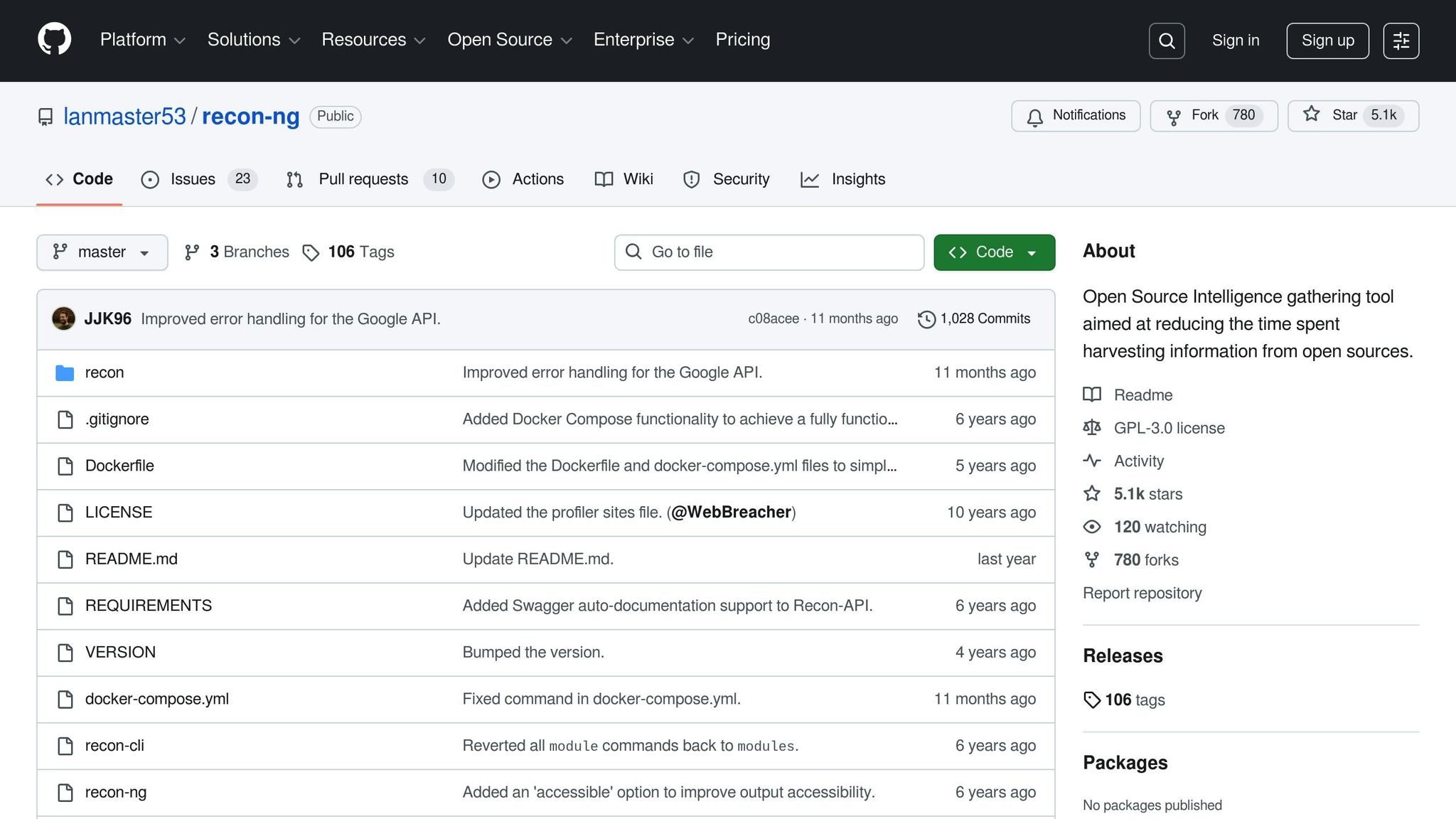
Recon-ng is a command-line framework designed for open-source intelligence (OSINT) gathering. It uses a modular approach to map potential vulnerabilities and threat surfaces.
Primary Use Case
Security teams rely on Recon-ng to assess their digital footprint. This involves collecting information on domains, subdomains, IP addresses, email addresses, and even employee details to uncover potential weak points.
Key Features
Recon-ng’s modular system allows users to select and install specific reconnaissance modules tailored to their needs. These modules can be chained together to automate workflows, pulling data from sources like search engines, social media platforms, and public databases. A built-in database stores all findings, simplifying analysis and reporting.
The framework also integrates with APIs, enabling access to premium data sources. This expands the range of information that can be gathered, making it a powerful tool for in-depth reconnaissance.
Strengths
Recon-ng’s modular design is one of its standout qualities, offering targeted intelligence gathering that adapts to the complexities of different digital environments. Security teams can focus their efforts on specific goals without running unnecessary modules that might waste time or resources.
Its command-line interface is particularly appealing to technical users, allowing for scripting and integration into broader security workflows. Additionally, the ability to save workspaces helps investigators manage multiple investigations simultaneously, keeping everything organized and efficient.
Limitations
Using Recon-ng effectively requires technical expertise. Users need to understand which modules to deploy and how to interpret the data they collect.
Another limitation is its reliance on external APIs. The availability and quality of results can depend on service uptime and rate limits. Moreover, some of the most useful modules require paid API keys, which could increase operational costs.
With Recon-ng’s features and limitations outlined, the next step is to see how it stacks up against other OSINT tools across critical criteria for security teams.
Tool Comparison Chart
Here’s a quick overview of various OSINT tools, highlighting their main uses, strengths, and limitations to help shape your threat intelligence approach:
| Tool | Primary Use Case | Key Strengths | Main Limitations |
|---|---|---|---|
| The Security Bulldog | AI-powered threat intelligence aggregation | Advanced NLP engine, automated analysis, MITRE ATT&CK integration | High cost at $850/month |
| Maltego | Visual link analysis and relationship mapping | Interactive graph visualization, extensive data transforms | Steep learning curve, requires high system performance |
| Shodan | Internet-connected device discovery | Real-time device scanning, API integration | Limited free tier, requires technical expertise |
| Censys | Internet infrastructure analysis | Certificate transparency, detailed host profiling | API rate limits, additional premium costs |
| TheHarvester | Email and subdomain enumeration | Free and open-source, supports multiple search engines | Manual operation, lacks automated workflows |
| VirusTotal | File and URL threat analysis | Comprehensive malware detection, community insights | File size limits, API restrictions |
| AbuseIPDB | IP reputation checking | Community-driven database, real-time threat feeds | Relies on user submissions, risk of false positives |
| Intelligence X | Deep web and darknet monitoring | Broad data coverage, historical search options | Expensive subscription, complex interface |
| Crimewall by Social Links | Social media intelligence gathering | Multi-platform monitoring, facial recognition | Privacy concerns, reliant on platform access |
| Recon-ng | Automated reconnaissance framework | Modular design, scriptable workflows | Command-line only, requires technical skills |
This chart builds on earlier discussions of these tools, offering a snapshot to refine your OSINT strategy for addressing technology threats.
Key Takeaways
Certain patterns stand out when comparing these tools. For instance, visual analysis tools like Maltego excel at mapping relationships but require time and training to master. On the other hand, infrastructure scanning tools such as Shodan and Censys provide detailed technical insights, but interpreting their results demands expertise.
AI-powered platforms like The Security Bulldog are designed to save time by automating complex analyses, making them ideal for teams aiming to boost efficiency. Meanwhile, open-source tools like TheHarvester and Recon-ng are great for those with technical skills but limited budgets.
Cost is another factor to consider. Open-source tools deliver basic functionality without charge, while enterprise solutions like The Security Bulldog offer advanced automation at a premium price. At $850/month, it’s a significant investment but may pay off in time savings.
Integration capabilities also vary widely. Before committing to a tool, evaluate how well it fits into your existing security setup. Some tools may require additional configuration or resources to work seamlessly with your infrastructure.
Finally, combining tools often yields the best results. For example, pairing Shodan for reconnaissance, Maltego for relationship mapping, and The Security Bulldog for ongoing monitoring creates a robust intelligence pipeline. Using a mix of specialized tools allows security teams to address threats more effectively and efficiently.
Conclusion
As the technology landscape continues to evolve, so do the threats within it. This makes relying on a single OSINT tool increasingly impractical. Instead, a hybrid approach that combines specialized tools for different aspects of threat intelligence often proves to be the most effective strategy.
Each OSINT tool brings something unique to the table. For instance, infrastructure scanners like Shodan and Censys provide detailed technical insights into exposed systems. However, juggling multiple tools can introduce its own challenges, particularly when it comes to correlating data across platforms – a process that can quickly become time-intensive.
This is where AI-powered platforms like The Security Bulldog step in to streamline the process. By automating analysis and integrating information from diverse sources, these platforms help security teams work smarter, not harder. The platform’s NLP engine organizes scattered threat data into actionable insights, significantly cutting down the time spent on research. At $850 per month, it’s an investment that allows analysts to prioritize strategic threat hunting and respond to incidents more efficiently.
FAQs
How can technology companies choose the right OSINT tools to meet their cybersecurity needs?
When selecting the best OSINT tools, technology companies need to start by clearly defining their objectives. Are they aiming to detect threats, manage vulnerabilities, or enhance incident response? Knowing the end goal helps narrow down the options.
Next, it’s crucial to assess how well the tools can handle key tasks like automating data collection, efficiently analyzing intelligence, and delivering insights that are actionable and relevant to their specific IT setup.
Another important factor is compatibility. The tools should integrate smoothly with existing systems, promote teamwork across departments, and address the organization’s unique security needs. A structured evaluation process – testing tools in real-world scenarios – can ensure they meet these criteria and provide dependable intelligence for quicker, more informed decisions.
Why is it better to use multiple OSINT tools instead of relying on just one?
Using a variety of OSINT tools allows security teams to gather data from multiple sources, offering a more complete and precise picture of potential threats. This approach minimizes blind spots, improves detection, and creates a deeper understanding of the threat environment.
By selecting tools designed for specific data types or tasks, teams can act more quickly and make well-informed decisions. This strategy streamlines threat management and strengthens overall cybersecurity preparedness.
How do AI and NLP in OSINT tools like The Security Bulldog improve threat intelligence?
AI and Natural Language Processing (NLP) play a pivotal role in OSINT tools like The Security Bulldog, transforming how threat intelligence is gathered and analyzed. By processing vast amounts of open-source data with incredible speed, NLP can sift through unstructured text to pull out crucial insights, recognize patterns, and uncover relationships. This makes spotting potential threats more efficient while cutting down on false positives.
AI takes it a step further by automating time-consuming tasks, such as identifying indicators of compromise, detecting anomalies in real time, and merging data from different sources. These advanced capabilities empower cybersecurity teams to act quickly, refine their response strategies, and strengthen the protection of their IT systems.